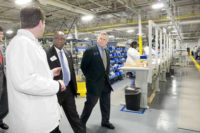American manufacturing is on the rise. According to the latest figures from the Labor Department, the nation’s factories added 50,000 jobs in January—their strongest showing in a year—on top of 32,000 jobs in December.
Overall, employers added 243,000 jobs in January, the most in nine months. Manufacturing was the second-biggest gainer, behind professional and business services.
Employment numbers aren’t the only indication that manufacturing activity is picking up. According to the Institute for Supply Management, growth in new factory orders rose to a nine-month high in January. And, vehicle sales in January rose to a seasonally adjusted annual rate of 14.2 million, the briskest pace in several years.
However, U.S. manufacturers are not out of the woods yet. Although the sector added 404,000 jobs from January 2010 to January 2012, it’s still down 3 million jobs from January 2003. And, the 11.8 million manufacturing jobs tabulated in January 2012 is still a fraction of the peak level of 19.5 million in 1979.
Other data provide further cause for concern. From March 2006 to March 2010, business start-ups are down 24 percent. In 1960, the United States accounted for more than two-thirds of global R&D. Today, two-thirds of global R&D is performed somewhere other than the United States.
A recent study by Booz & Co. grouped U.S. manufacturing sectors into four categories based on levels of global competitiveness. The study found that nearly half of the current U.S. manufacturing base is at risk. Con-versely, the study suggests that American factories still competitively produce about 75 percent of the goods sold in the United States and roughly 20 percent of goods sold globally.
Keeping the U.S. manufacturing sector on the upswing will require the coordinated action of business, labor, academia and government. Just such a plan was published in December by the Council on Competitiveness. Based in Washington, DC, the council is a nonprofit, nonpartisan organization dedicated to elevating U.S. productivity and leadership in world markets and raising the standard of living for all Americans.
Its report, Make: An American Manufacturing Movement, provides dozens of specific recommendations for addressing the five key challenges facing U.S. manufacturers:
Fueling the innovation and production economy.
* Expanding U.S. exports.
* Harnessing American talent.
* Achieving next-generation productivity.
* Creating next-generation supply networks.
“American manufacturing is either in steep decline, doing reasonably well, or poised to grow, depending on who you’re listening to,” says Jack McDougle, the council’s senior vice president for manufacturing. “You hear a lot of things in the press, but what is really going on? Could we peel away some of the rhetoric and think about [the challenges facing U.S. manufacturers] as globalization expands, industries mature, and things change? Could we develop...an appropriate response to those issues?”
McDougle will share the council’s recommendations for a robust manufacturing sector on May 2 during a keynote address to start Tech ManufactureXPO, a virtual trade show sponsored by ASSEMBLY, Quality, Appliance Design, Adhesives & Sealantsand World Trade 100. (See sidebar.)
Seeing the Big Picture
The Make report grew out of a series of meetings and interviews with the council’s membership: manufacturing executives, labor leaders, university presidents and national laboratory directors. (Those interviews can be read in a series of Ignite reports published by the council last year.) By bringing together disparate views, the council hoped to address the broader manufacturing economy, as opposed to any one industry or trade group.
One of the hallmarks of the Make report is its nuanced assessment of U.S. manufacturing and its multilateral approach to the challenges the sector faces. Indeed, many of the report’s findings are surprising.
For example, most people believe China and other low-cost labor centers are entirely responsible for the decline in U.S. manufacturing jobs. While that’s true to an extent, the reality is more complex. The loss of U.S. manufacturing jobs also stems from demand shifts, the value of the dollar, automation and productivity gains. The total cost of production includes labor, as well as other factors, such as taxes, trade rules, regulations, land, capital, energy and transportation systems.
“A lot of the political rhetoric, particularly here in Washington, is still about [manufacturers] chasing low-cost labor,” says McDougle. “That really isn’t the case. In fact, many foreign companies are investing in the United States because they are going after low-cost labor. European companies are investing heavily in the United States because it offers tremendous advantages. Look at Volkswagen, Daimler and Siemens. Companies want to locate here. The trick is how can we accelerate that?”
Similarly, many Americans would be surprised to learn that the largest share of U.S. foreign investment dollars is actually in high-cost European economies. For instance, total U.S. investment in Ireland over the past 10 years is more than three times greater than investment in China during the same period.
Top Priorities
Given the global economy, one of the council’s top priorities is to replace the current worldwide double taxation system with a territorial tax system to facilitate the repatriation of earnings. Reducing taxes on repatriated earnings to less than 5 percent, in line with European economies, would stimulate investment in new and existing U.S.-based manufacturing facilities.
“If U.S. companies have operations in foreign markets, the profits from those affiliates are not taxed in the United States unless they’re brought back here. Then, they’re taxed at the corporate rate, which is roughly 35 percent,” explains McDougle. “The United States is the only developed economy [with] that type of system. So, for example, when Siemens makes a profit here, they pay U.S. taxes. But when they bring those profits back to Germany, they don’t pay tax on it, or they pay a nominal 2 percent or 3 percent rate.
“In 2010, U.S. affiliate sales were three times greater than U.S. exports. A lot of our exports are actually going to U.S. firms operating in other countries, where they do final assembly. Our policies don’t take advantage of that business model. By our estimates, U.S. affiliate sales generated $1.4 trillion in profits globally. Most of that is sitting on corporate balance sheets with nowhere to go. ...If only [half of that] came back, it would be a huge stimulus.”







